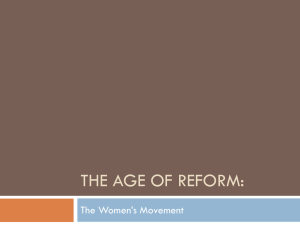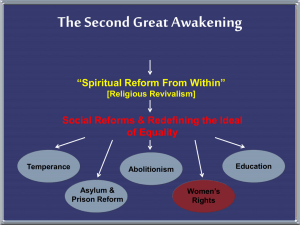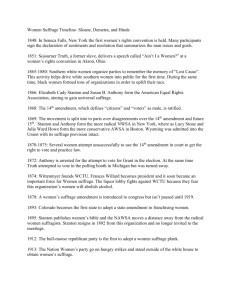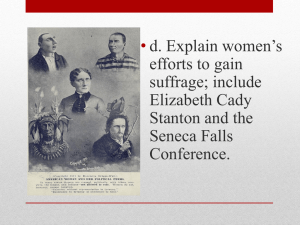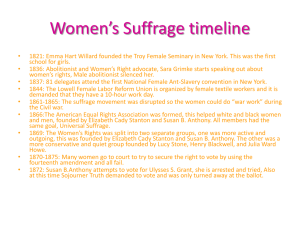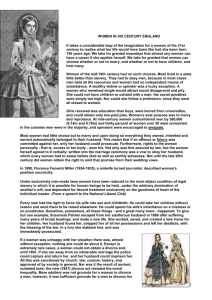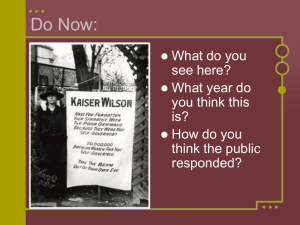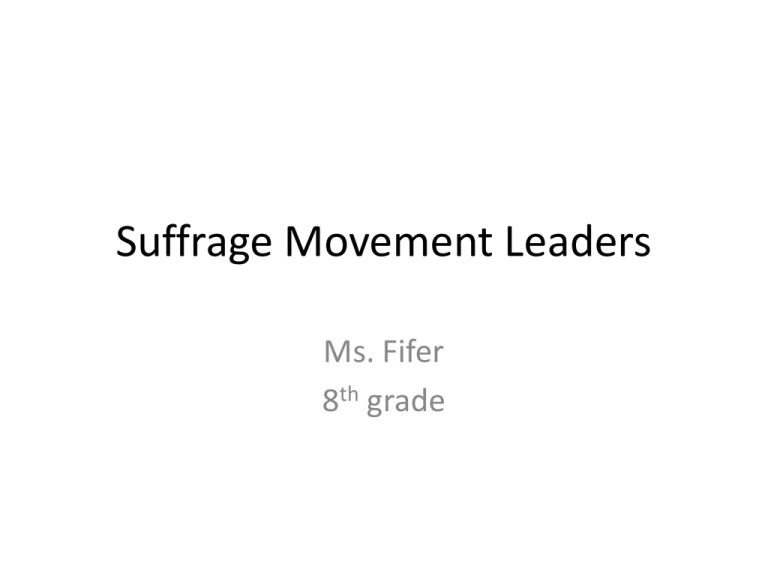
Suffrage Movement Leaders
Ms. Fifer
8th grade
Standard: Examine the women’s suffrage
movement (e.g., biographies, writings, and
speeches of Elizabeth Cady Stanton, Margaret
Fuller, Sojourner Truth, Lucretia Mott, and
Susan B. Anthony.
Objective: Student will create a
poster with a quote, picture,
timeline, and paragraph re: one of
the suffrage leaders.
Women’s Suffrage Movement
• What rights do women have now in the
United States?
• Do women have the same or different rights in
other countries?
• Have women always had the same rights?
Prerequisite Vocabulary
• Suffrage-the right to vote, especially in a political
election.
• Rights- that which is due to anyone by just claim,
legal guarantees, moral principles, etc.: women's
rights; freedom of speech is a right of all
Americans.
• Biography-a written account of another person's
life.
• Timeline-a linear representation of important
events in the order in which they occurred.
Elizabeth Cady Stanton
Elizabeth Cady Stanton
Women's rights activist, feminist, editor, and writer. Born on November 12, 1815, in Johnstown, New York. The daughter of a lawyer
who made no secret of his preference for another son, she early showed her desire to excel in intellectual and other "male" spheres.
She graduated from the Emma Willard's Troy Female Seminary in 1832 and then was drawn to the abolitionist, temperance, and
women's rights movements through visits to the home of her cousin, the reformer Gerrit Smith.
In 1840 Elizabeth Cady Stanton married a reformer Henry Stanton (omitting “obey” from the marriage oath), and they went at once
to the World's Anti-Slavery Convention in London, where she joined other women in objecting to their exclusion from the assembly.
On returning to the United States, Elizabeth and Henry had seven children while he studied and practiced law, and eventually they
settled in Seneca Falls, New York.
With Lucretia Mott and several other women, Elizabeth Cady Stanton held the famous Seneca Falls Convention in July 1848. At this
meeting, the attendees drew up its “Declaration of Sentiments” and took the lead in proposing that women be granted the right to
vote. She continued to write and lecture on women's rights and other reforms of the day. After meeting Susan B Anthony in the early
1850s, she was one of the leaders in promoting women's rights in general (such as divorce) and the right to vote in particular.
During the Civil War Elizabeth Cady Stanton concentrated her efforts on abolishing slavery, but afterwards she became even more
outspoken in promoting women suffrage. In 1868, she worked with Susan B. Anthony on the Revolution, a militant weekly paper. The
two then formed the National Woman Suffrage Association (NWSA) in 1869. Stanton was the NWSA’s first president—a position she
held until 1890. At that time the organization merged with another suffrage group to form the National American Woman Suffrage
Association. Stanton served as the president of the new organization for two years.
As a part of her work on behalf of women’s rights, Elizabeth Cady Stanton often traveled to give lectures and speeches. She called for
an amendment to the U.S. Constitution giving women the right to vote. Stanton also worked with Anthony on the first three volumes
of the History of Woman Suffrage (1881–6). Matilda Joslyn Gage also worked with the pair on parts of the project.
Besides chronicling the history of the suffrage movement, Elizabeth Cady Stanton took on the role religion played in the struggle for
equal rights for women. She had long argued that the Bible and organized religion played in denying women their full rights. With her
daughter, Harriet Stanton Blatch, she published a critique, The Woman's Bible, which was published in two volumes. The first volume
appeared in 1895 and the second in 1898. This brought considerable protest not only from expected religious quarters but from
many in the woman suffrage movement.
Elizabeth Cady Stanton died on October 26, 1902. More so than many other women in that movement, she was able and willing to
speak out on a wide spectrum of issues—from the primacy of legislatures over the courts and constitution, to women's right to ride
bicycles—and she deserves to be recognized as one of the more remarkable individuals in American history.
© 2010 A&E Television Networks. All Rights Reserved.
© 2011 A&E Television Networks. All rights reserved.
Sojourner Truth
Sojourner Truth
•
(born 1797, Ulster county, N.Y., U.S.—died Nov. 26, 1883, Battle Creek, Mich.) African American evangelist and reformer who applied her religious
fervour to the abolitionist and women's rights movements.
•
Isabella was the daughter of slaves and spent her childhood as an abused chattel of several masters. Her first language was Dutch. Between 1810 and
1827 she bore at least five children to a fellow slave named Thomas. Just before New York state abolished slavery in 1827, she found refuge with
Isaac Van Wagener, who set her free. With the help of Quaker friends, she waged a court battle in which she recovered her small son, who had been
sold illegally into slavery in the South. About 1829 she went to New York City with her two youngest children, supporting herself through domestic
employment.
•
Since childhood Isabella had had visions and heard voices, which she attributed to God. In New York City she became associated with Elijah Pierson, a
zealous missionary. Working and preaching in the streets, she joined his Retrenchment Society and eventually his household.
•
In 1843 she left New York City and took the name Sojourner Truth, which she used from then on. Obeying a supernatural call to “travel up and down
the land,” she sang, preached, and debated at camp meetings, in churches, and on village streets, exhorting her listeners to accept the biblical
message of God's goodness and the brotherhood of man. In the same year, she was introduced to abolitionism at a utopian community in
Northampton, Massachusetts, and thereafter spoke in behalf of the movement throughout the state. In 1850 she traveled throughout the Midwest,
where her reputation for personal magnetism preceded her and drew heavy crowds. She supported herself by selling copies of her book, The
Narrative of Sojourner Truth, which she had dictated to Olive Gilbert.
•
Encountering the women's rights movement in the early 1850s, and encouraged by other women leaders, notably Lucretia Mott, she continued to
appear before suffrage gatherings for the rest of her life. (To read an account of one of Sojourner Truth's speeches, Sojourner Truth: What Time of
Night It Is.)
•
In the 1850s Sojourner Truth settled in Battle Creek, Michigan. At the beginning of the American Civil War, she gathered supplies for black volunteer
regiments and in 1864 went to Washington, D.C., where she helped integrate streetcars and was received at the White House by President Abraham
Lincoln. The same year, she accepted an appointment with the National Freedmen's Relief Association counseling former slaves, particularly in
matters of resettlement. As late as the 1870s she encouraged the migration of freedmen to Kansas and Missouri. In 1875 she retired to her home in
Battle Creek, where she remained until her death.
•
Copyright © 1994-2010 Encyclopædia Britannica, Inc. For more information visit Britannica.com
Susan B. Anthony
Susan B. Anthony
•
Women's History Figure. It may be hard to imagine, but women didn't always have the right to vote. It took the hard work and dedication of people,
such as Susan B. Anthony, to make that happen. She spent much of her life fighting for causes she believed in, especially for women's suffrage, or the
right to vote.
•
Born on February 15, 1820, in Adams, Massachusetts, Anthony grew up in a politically active family. They worked to end slavery in what was called
the abolitionist movement. They were also part of the temperance movement, which wanted the production and sale of alcohol limited or stopped
completely. Anthony was inspired to fight for women's rights while campaigning against alcohol. She denied a chance to speak at a temperance
convention because she was a woman. Anthony later realized that no one would take women in politics seriously unless they had the right to vote.
•
Along with activist Elizabeth Cady Stanton, Anthony founded the National Woman Suffrage Association in 1869. Around this time, the two created
and produced The Revolution, a weekly publication that lobbied for women's rights. Later the pair edited three volumes of History of Woman
Suffrage together.
•
Anthony was tireless in her efforts, giving speeches around the country to convince others to support a woman's right to vote. She even took matters
into her own hands in 1872 when she voted in the presidential election illegally. Anthony was arrested and tried unsuccessfully to fight the charges.
She ended up being fined $100—a fine she never paid.
•
When Anthony died on March 13, 1906, women still did not have the right to vote. It wasn't until 1920, 14 years after her death, that the 19th
Amendment to the U.S. Constitution—giving all adult women the right to vote—was passed. In recognition of her dedication and hard work, the U.S.
Treasury Department put Anthony's portrait on one dollar coins in 1979, making her the first woman to be so honored.
•
© 2011 A&E Television Networks. All rights reserved.
Margaret Fuller
Margaret Fuller
•
Feminist, writer, literary critic. Born on May 23, 1810, in Cambridgeport, Massachusetts. Her father, Timothy Fuller, was a prominent Massachusetts
lawyer-politician who, disappointed that his child was not a boy, educated her rigorously in the classical curriculum of the day. Not until age 14 did
she attend school (1824–6) and then returned to Cambridge and her course of reading. Her intellectual precociousness gained her the acquaintance
of various Cambridge intellectuals, but her assertive and intense manner put many people off. Her father moved the family to a farm in Groton,
Massachusetts, in 1833, and she found herself isolated and forced to help educate her siblings and run the household for her ailing mother.
•
After visiting Ralph Waldo Emerson in Concord, Margaret Fuller taught for Bronson Alcott in Boston from 1836 to 1837, and then at a school in
Providence, Rhode Island. During this time she continued to enlarge both her intellectual accomplishments and personal acquaintances. Moving to
Jamaica Plain, a suburb of Boston, in 1840, she conducted her famous “Conversations,” discussion groups that attracted many prominent people
from all around Boston from 1840 to 1844.
•
Margaret Fuller also joined Ralph Waldo Emerson and others to found the Dial, a journal devoted to transcendentalist views in 1840. She became a
contributor from the first issue and its editor. Her first book, based on a trip through the Midwest, was Summer on the Lakes (1844) and this led to
an invitation by Horace Greeley to be literary critic at the New York Tribune that same year. She published her feminist classic, Woman in the
Nineteenth Century, in 1845. In addition to writing a solid body of critical reviews and essays, she became active in various social reform movements.
In 1846 she went to Europe as a foreign correspondent for the Tribune, and in England and France she was regarded as a serious intellectual and met
many prominent people.
•
Traveling to Italy in 1847, Margaret Fuller met Giovanni Angelo, the Marchese d'Ossoli, ten years younger and of liberal principles. They became
lovers, had a son in 1848, and married the next year. Involved in the Roman revolution of 1848, Fuller and her husband fled to Florence in 1849. They
sailed for the United States but the ship ran aground in a storm off Fire Island, New York, and their bodies were never found.
•
© 2011 A&E Television Networks. All rights reserved
Mary Church Terrell
Mary Church Terrell
•
(born Sept. 23, 1863, Memphis, Tenn., U.S.—died July 24, 1954, Annapolis, Md.) American social activist who was cofounder
and first president of the National Association of Colored Women. She was an early civil rights advocate, an educator, an
author, and a lecturer on woman suffrage and rights for African Americans.
•
Mary Church was the daughter of Robert Reed Church and Louisa Ayers Church, both former slaves prominent in the
growing black community of Memphis, Tennessee. Both parents owned small, successful businesses, and they provided
“Mollie” and her brother with advantages that few other African American children of her time enjoyed. She received a
bachelor's degree from Oberlin College in Ohio in 1884. She taught languages at Wilberforce University and at a black
secondary school in Washington, D.C. After a two-year tour of Europe, she completed a master's degree from Oberlin (1888)
and married Robert Heberton Terrell, a lawyer who would become the first black municipal court judge in the nation's
capital.
•
An early advocate of women's rights, Terrell was an active member of the National American Woman Suffrage Association,
addressing in particular the concerns of black women. In 1896 she became the first president of the newly formed National
Association of Colored Women, an organization that under her leadership worked to achieve educational and social reform
and an end to discriminatory practices. Appointed to the District of Columbia Board of Education in 1895, Terrell was the
first black woman to hold such a position. At the suggestion of W.E.B. Du Bois, she was made a charter member of the
National Association for the Advancement of Colored People, and in 1949 she gained entrance to the Washington chapter of
the American Association of University Women, bringing to an end its policy of excluding blacks.
•
An articulate spokeswoman, adept political organizer, and prolific writer, Terrell addressed a wide range of social issues in
her long career, including the Jim Crow Law, lynching, and the convict lease system. Her last act as an activist was to lead a
successful three-year struggle against segregation in public eating places and hotels in the nation's capital. Her
autobiography, A Colored Woman in a White World, appeared in 1940.
•
Copyright © 1994-2010 Encyclopædia Britannica, Inc. For more information visit Britannica.com
Lucretia Mott
Lucretia Mott
•
Women's rights activist, abolitionist, and religious reformer. Born Lucretia Coffin on January 3, 1793, in Nantucket, Massachusetts. A child of Quaker
parents, Lucretia Mott grew up to become a leading social reformer. At the age of 13, she attended a Quaker boarding school in New York State.
Mott stayed on and worked there as a teaching assistant. While at the school, she met her future husband James Mott. The couple married in 1811
and lived in Philadelphia.
•
By 1821, Lucretia Mott became a Quaker minister, noted for her speaking abilities. She and her husband went over with the more progressive wing
of their faith in 1827. Mott was strongly opposed to slavery, and advocated not buying the products of slave labor, which prompted her husband,
always her supporter, to get out of the cotton trade around 1830. An early supporter of William Lloyd Garrison and his American Anti-Slavery Society,
she often found herself threatened with physical violence due to her radical views.
•
Lucretia Mott and her husband attended the famous World's Anti-Slavery Convention in London in 1840, the one that refused to allow women to be
full participants. This led to her joining Elizabeth Cady Stanton in calling the famous Seneca Falls Convention in New York in 1848 (at which, ironically,
James Mott was asked to preside), and from that point on she was dedicated to women's rights and published her influential Discourse on Woman
(1850). While remaining within the Society of Friends, in practice and beliefs she actually identified increasingly with more liberal and progressive
trends in American religious life, even helping to form the Free Religious Association in Boston in 1867.
•
While keeping up her commitment to women's rights, she also maintained the full routine of a mother and housewife, and continued after the Civil
War to work for advocating the rights of African-Americans. She helped to found Swarthmore College in 1864, continued to attend women's rights
conventions, and when the movement split into two factions in 1869, she tried to bring the two together.
•
Lucretia Mott died on November 11, 1880.
•
© 2011 A&E Television Networks. All rights reserved.
Lets Review!
• Who had their portrait on a coin?
• Who led a 3 year struggle against segregation
in public eating places in the nation’s capital?
• Who helped found Swarthmore College?
• Who was involved in the Roman revolution?
• Who was the daughter of slaves?
• Who was the daughter of a lawyer?
Let’s create a brochure
• Front cover-your name, date, block
• Front left flap- picture, paragraph, 5 events of
their life, and name.
• Middle flap- picture, paragraph, 5 events of
their life, and name.
• Front right flap-picture, paragraph, 5 events of
their life, and name.
Bibliography
• 2011 A&E Television Network
• Webster.com
• 1994-2010 Encylopedia Britanica, Inc
Rubric for Suffrage brochure
• RubricStateBrochure.doc
Lesson plan p. 1
Standard & US 8.6.6- Examine the women’s suffrage movement (e.g.,
biographies, writings, and speeches of Elizabeth Cady Stanton, Margaret
Fuller, Lucretia Mott, Susan B. Anthony, etc).
Lesson Objective: Students will create a brochure with three leaders that
include a picture, timeline, and biography of each of the three leaders involved
in the women’s suffrage movement.
Lesson Design Context (Presentation)
STEP 1: Orientation to Lesson
Lesson Objectives
STEP 2: Preteach
Prior Skills/Advanced Organizers
Language Objective
Prerequisite Vocab
STEP 3: Teach
Vocabulary/Academic Language
Demonstrate, Model, Explain…
Direct Delivery
Meaningful Interaction
Chunking & Scaffolding
Lesson Delivery
-Students will be able to state two items
about one of the leaders of the suffrage
movement.
Step 2What rights do women have now in the
U.S.?, Do women have the same or
different rights in other countries?, Have
women always had the same rights?
Language objective- biography, timeline
Acad. Lang-Suffrage, rights
Whip around what is suffrage?
Powerpoint presentation- Suffrage
Movement Leaders
Checking for understanding quiz-
Lesson plan p.2
STEP 4: Guided Practice
Questioning
Pair Work
Cooperative Learning
Teacher highly involved
Formal Assessment of Mastery
STEP 5: Closure
Written and verbal
Tied to Objective
Quick Reflection/Wrap-Up
Review checking for understanding quiz
Students fill out worksheet w/ a partner
re: all 6 of the suffrage leaders.
Students will create questions and
answers on Cornell notes about 1
specific suffrage leader (#’ered off)
Students will sketch a picture of one of
the leaders and write 2 sentences about
the person.
STEP 6: Universal Access
Carefully selected based on prior
instruction
Tied to Objectives
Differentiated Instruction * Those who need
extra support
Independent
Practice
* Those who get it
OR
Students will select three of the leaders
of suffrage and create a brochure of 3 of
them. It must include a picture, 5
important events on their timeline, and
a paragraph as to what made each of
them a leader. Differentiated
Instruction-picture, 3 events on timeline,
paragraph what changes they made.

